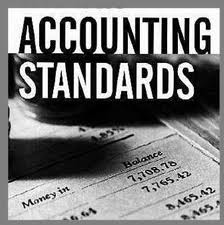SUMMARY OF IAS 1
The objective of IAS 1 (2007) is to prescribe the basis for presentation of general purpose financial statements, to ensure comparability both with the entity’s financial statements of previous periods and with the financial statements of other entities.
To meet that objective, financial statements provide information about an entity’s:
- assets , liabilities , equity , income and expenses, including gains and losses , cash flows
A complete set of financial statements should include:
- a statement of financial position (balance sheet) at the end of the period
- a statement of comprehensive income for the period (or an income statement and a statement of comprehensive income)
Regarding issued share capital and reserves, the following disclosures are required:
- numbers of shares authorised, issued and fully paid, and issued but not fully paid
- par value
- reconciliation of shares outstanding at the beginning and the end of the period
- description of rights, preferences, and restrictions
- treasury shares, including shares held by subsidiaries and associates
- shares reserved for issuance under options and contracts
- a description of the nature and purpose of each reserve within equity
An entity must disclose, in the summary of significant accounting policies or other notes, the judgements, apart from those involving estimations, that management has made in the process of applying the entity’s accounting policies that have the most significant effect on the amounts recognised in the financial statements.
SUMMARY OF IAS 2
IAS2(Inventories) (International Accounting Standard) deals with inventory and stock in trade.
To compute cost of sales in periodic system purchases are recorded in the purchase account. Opening balance of inventory is added to that amount and an inventory count is performed at year end. This inventory count gives an amount of closing inventory. In perpetual system accountant updates the balance of closing inventory after every transaction involving inventory. It means after every purchase and sales accountant get to know about the inventory balance.
SUMMARY OF IAS 3
Disclosures required in consolidated financial statements:
The nature of the relationship between the parent and a subsidiary when the parent does not own, directly or indirectly through subsidiaries, more than half of the voting power,The reasons why the ownership, directly or indirectly through subsidiaries, of more than half of the voting or potential voting power of an investee does not constitute control,the reporting date of the financial statements of a subsidiary when such financial statements are used to prepare consolidated financial statements and are as of a reporting date or for a period that is different from that of the parent, and the reason for using a different reporting date or period, andThe nature and extent of any significant restrictions on the ability of subsidiaries to transfer funds to the parent in the form of cash dividends or to repay loans or advances.
SUMMARY OF IAS 4
The objective of IAS 16 is to prescribe the accounting treatment for property, plant, and equipment.
The principal issues are the recognition of assets, the determination of their carrying amounts, and the depreciation charges and impairment losses to be recognised in relation to them.
Disclosure:
For each class of property, plant, and equipment, disclose:
Basis for measuring carrying amount , depreciation method(s) used , useful lives or depreciation rates , gross carrying amount and accumulated depreciation and impairment losses ,
Reconciliation of the carrying amount at the beginning and the end of the period, showing:
Additions disposals, acquisitions through business combinations, revaluation increases or decreases, impairment losses, reversals of impairment losses, Depreciation.
SUMMARY OF IAS 5
Disclosures:
- numbers of shares authorised, issued and fully paid, and issued but not fully paid
- par value
- reconciliation of shares outstanding at the beginning and the end of the period
- description of rights, preferences, and restrictions
- treasury shares, including shares held by subsidiaries and associates
- shares reserved for issuance under options and contracts
- a description of the nature and purpose of each reserve within equity
An entity must disclose, in the summary of significant accounting policies or other notes, the judgements, apart from those involving estimations, that management has made in the process of applying the entity’s accounting policies that have the most significant effect on the amounts recognised in the financial statements.
SUMMARY OF IAS 6
The objective of IAS 15 is to specify disclosures reflecting the effects of changing prices on the measurements used in the determination of an enterprise’s results of operations and its financial position.
The following items should be disclosed, at a minimum, based on the chosen method for reflecting the effects of changing prices:
- Adjustment to depreciation
- Adjustment to cost of sales
- Adjustments relating to monetary items
- The overall effect on net income of the above three items
- Current cost of property, plant and equipment and of inventories, if the current cost approach is used
- Description of the methods used to compute the above adjustments
The disclosures can be made on a supplementary basis or in the primary financial statements.
SUMMARY OF IAS 7
A cash flow statement provides information on changes in cash and cash equivalents during a
reporting period. Cash equivalents are short-term, highly liquid investments that are readily
convertible to known amounts of cash and subject to an insignificant risk of changes in value.
Operating activities are the principal revenue-producing activities of the entity. They also include
activities that are not investing or financing activities. Cash flows from Operating activities are
reported using either:
- the direct method, whereby major classes of gross cash receipts and gross cash
payments are disclosed; or
- the indirect method, whereby profit or loss for the period is adjusted for non-cash items, and ite Cash flows are usually reported gross. Cash flows from interest and dividends are
disclosed separately as either operating, investing or financing activities.
Cash flows from taxes on income are also disclosed separately within operating activities.ms of income or expense related to investing and financing activities. IAS 7 specifies disclosures about cash and cash equivalents and certain non-cash transactions.
SUMMARY OF IAS 8
Disclosures Relating to Changes in Accounting Policies
- the title of the standard or interpretation causing the change
- the nature of the change in accounting policy
- a description of the transitional provisions, including those that might have an effect on future periods
- for the current period and each prior period presented, to the extent practicable, the amount of the adjustment:
- for each financial statement line item affected, and
- for basic and diluted earnings per share
Disclosure:
- the nature and amount of a change in an accounting estimate that has an effect in the current period or is expected to have an effect in future periods
- if the amount of the effect in future periods is not disclosed because estimating it is impracticable, an entity shall disclose that fact.
SUMMARY OF IAS 9
The objective of IAS 9 is to prescribe the accounting treatment for intangible assets that are not dealt with specifically in another IFRS. The Standard requires an entity to recognise an intangible asset if, and only if, certain criteria are met. The Standard also specifies how to measure the carrying amount of intangible assets and requires certain disclosures regarding intangible assets.
Disclosure of Research and Development Information
(a) the amount of deferred research and development costs at the end of the period; and
(b) the basis for amortising any deferred research and development costs.
SUMMARY OF IAS 10
Non-adjusting events should be disclosed if they are of such importance that non-disclosure would affect the ability of users to make proper evaluations and decisions. The required disclosure is (a) the nature of the event and (b) an estimate of its financial effect or a statement that a reasonable estimate of the effect cannot be made.
A company should update disclosures that relate to conditions that existed at the end of the reporting period to reflect any new information that it receives after the reporting period about those conditions. Companies must disclose the date when the financial statements were authorized for issue and who gave that authorization. If the enterprise’s owners or others have the power to amend the financial statements after issuance, the enterprise must disclose that fact
SUMMARY OF IAS 11
The objective of IAS 11 is to prescribe the accounting treatment of revenue and costs associated with construction contracts. If the outcome of a construction contract can be estimated reliably, revenue and costs should be recognised in proportion to the stage of completion of contract activity.
Disclosure:
- amount of contract revenue recognised;
- method used to determine revenue;
- method used to determine stage of completion
SUMMARY OF IAS 12
IAS 12 prescribes the accounting treatment for income taxes, that is, taxes that are based on taxable profit. Income taxes include all domestic and foreign income taxes including foreign withholding taxes payable by a subsidiary, associate or joint venture on distributions to the reporting entity. Therefore, the standard applies to UK corporation tax that is assessed on an entity’s profits.
IAS 1 requires disclosures on the face of the statement of financial position about current tax assets, current tax liabilities, deferred tax assets, and deferred tax liabilities
SUMMARY OF IAS 13
Current assets are cash; cash equivalent; assets held for collection, sale, or consumption within the entity’s normal operating cycle; or assets held for trading within the next 12 months. All other assets are noncurrent. Current liabilities are those expected to be settled within the entity’s normal operating cycle or due within 12 months, or those held for trading, or those for which the entity does not have an unconditional right to defer payment beyond 12 months. Other liabilities are noncurrent.
SUMMARY OF IAS 14
IAS 14 has detailed guidance as to which items of revenue and expense are included in segment revenue and segment expense. All companies will report a standardised measure of segment result – basically operating profit before interest, taxes, and head office expenses. For an entity’s primary segments, revised IAS 14 requires disclosure of:
- sales revenue (distinguishing between external and intersegment)
- result
- assets
- the basis of intersegment pricing
- liabilities
- capital additions
- revenue
SUMMARY OF IAS 15
The objective of IAS 15 is to specify disclosures reflecting the effects of changing prices on the measurements used in the determination of an enterprise’s results of operations and its financial position.
The following items should be disclosed, at a minimum, based on the chosen method for reflecting the effects of changing prices:
- Adjustment to depreciation
- Adjustment to cost of sales
- Adjustments relating to monetary items
- The overall effect on net income of the above three items
SUMMARY OF IAS 16
The objective of IAS 16 is to prescribe the accounting treatment for property, plant, and equipment. For each class of property, plant, and equipment, discloses:
- basis for measuring carrying amount
- depreciation method(s) used
- useful lives or depreciation rates
- gross carrying amount and accumulated depreciation and impairment losses
SUMMARY OF IAS 17
The objective of IAS 17 (1997) is to prescribe, for lessees and lessors, the appropriate accounting policies and disclosures to apply in relation to finance and operating leases.
Disclosure: Lessees – Finance Lease and operating leases
- carrying amount of asset
- reconciliation between total minimum lease payments and their present value
- contingent rent recognised as an expense
- total future minimum sublease income under noncancellable subleases
- beyond five years
- amounts of minimum lease payments at balance sheet date under noncancellable operating leases for:
- the next year
- years 2 through 5 combined
SUMMARY OF IAS 18
IAS 18 prescribes the accounting treatment for revenue arising from:
• The sale of goods; The rendering of services; and The use by others of entity assets yielding interest, royalties and dividends.
Disclosure :
- accounting policy for recognising revenue
- amount of each of the following types of revenue:
- sale of goods
SUMMARY OF IAS 19
An IAS 19 Employee benefit prescribes the accounting and disclosure by employers for employee benefits (ie all forms of consideration given by an entity in exchange for service rendered by an employee.) Such consideration will include wages and salaries and other forms of remuneration as well as pension benefits, and termination benefits.
SUMMARY OF IAS 20
IAS 20 is long established and became operative for financial statements covering periods beginning on or after 1 January 1984. It provides guidance on the accounting treatment of government grants (which is very similar to that in the equivalent standard in the United Kingdom – SSAP 4) and on the disclosure requirements for government grants and other forms of government assistance.
SUMMARY OF IAS 21
The objective of IAS 21 is to prescribe how to include foreign currency transactions and foreign operations in the financial statements of an entity and how to translate financial statements into a presentation currency.
Disclosure
- The amount of exchange differences recognised in profit or loss .
- Net exchange differences recognised in other comprehensive income and accumulated in a separate component of equity, and a reconciliation of the amount of such exchange differences at the beginning and end of the period.
SUMMARY OF IAS 22
The objective of IAS 22 is to prescribe the accounting treatment for business combinations. The Standard covers both an acquisition of one enterprise by another (an acquisition) and also the rare situation where an acquirer cannot be identified (a uniting of interests).
These disclosures apply to all business combinations
- Names and descriptions of the combining enterprises.
- Method of accounting for the combination.
- Effective date of the merger.
- Plans to dispose of a portion of the combined enterprise
SUMMARY OF IAS 23
Borrowing costs are interest and other costs incurred by an entity in connection with the borrowing of funds.
Disclosure:
- the accounting policy adopted [required only until 1 January 2009 if immediate expensing model was used]
- amount of borrowing cost capitalised during the period , capitalisation rate used
SUMMARY OF IAS 24
The objective of IAS 24 is to ensure that an entity’s financial statements contain the disclosures necessary to draw attention to the possibility that its financial position and profit or loss may have been affected by the existence of related parties and by transactions and outstanding balances with such parties. Relationships between parents and subsidiaries. Regardless of whether there have been transactions between a parent and a subsidiary, an entity must disclose the name of its parent and, if different, the ultimate controlling party. If neither the entity’s parent nor the ultimate controlling party produces financial statements available for public use, the name of the next most senior parent that does so must also be disclosed.
SUMMARY OF IAS 25
IAS 40 covers investment property held by all enterprises and is not limited to enterprises whose main activities are in this area. Investment property is property (land or a building – or part of a building – or both) held (by the owner or by the lessee under a finance lease) to earn
Disclosure:
Both Fair Value Model and Cost Model [IAS 40.75]
- whether the fair value or the cost model is used
- if the fair value model is used, whether property interests held under operating leases are classified and accounted for as investment property
- if classification is difficult, the criteria to distinguish investment property from owner-occupied property and from property held for sale
SUMMARY OF IAS 26
IAS 26 Accounting and Reporting by Retirement Benefit Plansapplies to the financial statements of retirement benefit plans and thus has limited application to the entities, funds, accounts and flows covered by the IFRS FReM. It will be of relevance to the resource accounts prepared by the major schemes within central government
SUMMARY OF IAS 27
The nature of the relationship between the parent and a subsidiary when the parent does not own, directly or indirectly through subsidiaries, more than half of the voting power, the reasons why the ownership, directly or indirectly through subsidiaries, of more than half of the voting or potential voting power of an investee does not constitute control, the reporting date of the financial statements of a subsidiary when such financial statements are used to prepare consolidated financial statements .
SUMMARY OF IAS 28
IAS 28 applies to all investments in which an investor has significant influence but not control or joint control except for investments held by a venture capital organisation, mutual fund, unit trust, and similar entity that are designated under IAS 39 to be at fair value with fair value changes recognised in profit or loss.
The following disclosures are required:
- fair value of investments in associates for which there are published price quotations
- summarised financial information of associates, including the aggregated amounts of assets, liabilities, revenues, and profit or loss .
SUMMARY OF IAS 29
IAS 29 will be interpreted in the same way as FRS 24 – in that as all entities covered by this Manual have a functional currency of pounds sterling, HM Treasury will notify classification of hyperinflationary economy if appropriate.
- Gain or loss on monetary items [IAS 29.9]
- The fact that financial statements and other prior period data have been restated for changes in the general purchasing power of the reporting currency .
- Whether the financial statements are based on an historical cost or current cost approach
SUMMARY OF IAS 30
The objective of IAS 30 is to prescribe appropriate presentation and disclosure standards for banks and similar financial institutions (hereafter called ‘banks’), which supplement the requirements of other Standards.
Presentation and Disclosure
A bank’s income statement should group income and expenses by nature. A bank’s income statement or notes should report the following specific amounts:
- interest income
- interest expense
- dividend income
- fee and commission income
- fee and commission expense
- net gains/losses from securities dealing
- net gains/losses from investment securities
net gains/losses from foreign currency dealing
















